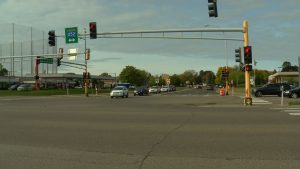Survey: Brooklyn Center Residents Want More Input on Highway 252 Freeway Project
About 170 residents who live along Highway 252 in Brooklyn Center participated in a survey that revealed substantial dissatisfaction with the proposed Highway 252 freeway conversion project.
 The survey was conducted by the Highway 252 Safety Task Force. It was a way for citizens to voice their opinions on the proposal to turn Highway 252 into a freeway.
The survey was conducted by the Highway 252 Safety Task Force. It was a way for citizens to voice their opinions on the proposal to turn Highway 252 into a freeway.
Earlier this year, MnDOT put on hold converting 252 into an expressway. Since that time, residents say MnDOT and the city of Brooklyn Center have declined any citizen input.
“When we tried to talk to city staff recently, they said no they wouldn’t talk to us. When we tried to go to the technical meetings they said ‘no you can’t come,'” explained Stephen Cooper, a Highway 252 Safety Task Force volunteer.
Survey Results
Surveys were delivered to homes, townhomes and accessible apartments. The survey sought to obtain the opinions of everyone interested who lived in the Highway 252 area in Brooklyn Center. A few of the findings are listed below. For a full copy of the survey results click here.
- 99% felt public engagement was important.
- 90.63% felt distance between interchanges should comply or substantially comply with MnDOT rules.
- 93.33% felt it was either very or somewhat important to minimize additional traffic on residential streets.
- 93.29% thought protecting the Mississippi River was very or somewhat important.
- 96.97% felt reducing or at least not increasing pollution was very or somewhat important.
Results also showed that more than half of the residents were not in favor of making 252 into an expressway at all. However, most still wanted improvements because the 252 stretch has some of the most dangerous intersections in Minnesota.
Proposed Expressway Concerns
The proposed freeway runs from Highway 610 in Brooklyn Park to I-94/694 in Brooklyn Center. There would be three interchange locations including 85th Avenue, Brookdale Drive and 66th Avenue.
Brooklyn Center residents are concerned about the proposed interchange on 66th due to pollution and the impact on the nearby Mississippi River, as well as the estimated traffic increase of 50,000 cars per day.
Residents are also very concerned about the distance between 66th Avenue and the interchange. The minimum recommended distance between urban interchanges is a mile. However, the proposal is only one-third of a mile.
Cooper also explained that MnDOT rules require a minimum of 2,000 feet for entry acceleration lanes on expressways. The proposed interchange would only allow 800 feet for drivers to accelerate.
Tom Kouri, a Highway 252 Safety Task Force volunteer, explained that there are better options for the interchange including on 73rd Avenue. He said it will allow more time for drivers to safely merge.
“A little bit farther north, there’s land that the city owns where there would not be a need to impact very many residents,” said Kouri. “That would be much farther from the Mississippi River, but most importantly be safe because distance is farther away.”
City Responds
The city of Brooklyn Center has responded to the citizen group that accuses the city and the Minnesota Department of Transportation of not accepting enough input over the Highway 252 freeway conversion project.
Brooklyn Center says that’s nowhere even close to the case.
“In recent weeks the City Council has met twice with MnDot representative specifically to discuss the best way to receive comprehensive, robust and representative citizen input and engagement in the current ongoing EIS process for the 252 highway conversion project. We expect that the EIS process will involve very robust representative and diverse community engagement as part of that process. The Council and MnDOT have made it abundantly clear that broad, diverse community input and engagement will be paramount to making the best decision.
The statements regarding 2000 foot and mile distance “minimums” stated in your story report are misleading statements at best; because they do not include other safety measures that are often used to compensate for the single guidance related to distance. I strongly encourage your reporters to reach out to MnDot on an informational background basis or listen to the public meetings where this issue has been repeatedly explained.
The safety Taskforce was created as an autonomous body of self-selected interested residents. According to the proclamation establishing the taskforce it is autonomous and independent of the City. The staff has never refused and will continue to answer questions and provided information to the Task force upon request as the proclamation requires.” Curt Boganey, city manager of Brooklyn Center


